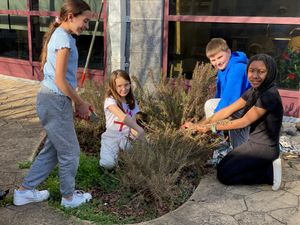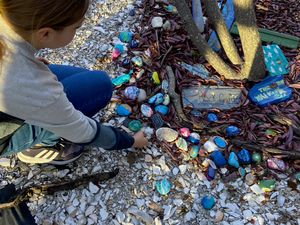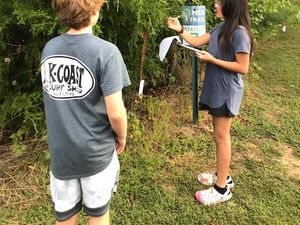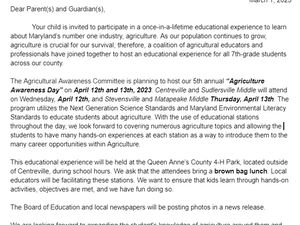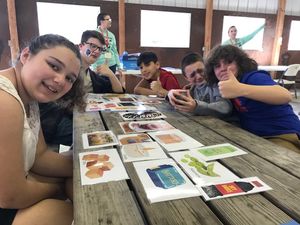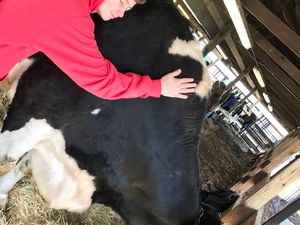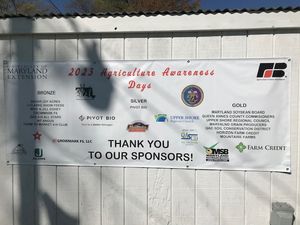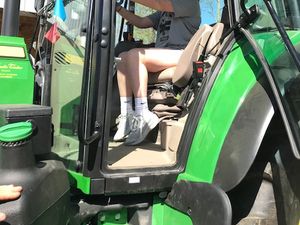Systemic Sustainability
Environmental Curriculum and Instruction
1.1 Curriculum and Instruction
Elementary & middle schools must provide one example of outdoor/environmental instruction per grade level.
High schools must provide one example of outdoor/environmental instruction in four subjects (which may include multiple different differents sciences).
As they complete the activities, students will apply STEM skills to learn the following: · The value of trees · How to identify trees · How to measure and assess the health of trees · How to calculate the dollar value of the benefits that trees provide using the i-Tree Design tool · How to analyze and interpret their findings · How to use i-Tree tools to develop plans to improve the environmental functions that trees provide on their school grounds or in their community.
6th grade students complete the Budburst Unit throughout the school year. Groups of students are assigned a tree to observe and determine when it is experiencing different phenotypes.
Budburst Report (8.38 KB)
Students complete the Budburst report throughout the school year to analyze changes.
Students will examine different types of materials (black and white cloth and aluminum foil) and determine how the solar energy interacts with them differently. They will utilize the temperature difference between the three to determine this.
Energy_MMSLesson Plan.doc (6.64 KB)
Students will Explore phenomena related to energy-efficiency, such as the example above (in intro) involving light bulbs. Plan and carry our investigations, and analyze data to figure out how energy is transferred and transformed. Engage in engineering challenges to design and test devices to maximize and minimize energy transfer. Investigate the issue of energy-efficiency and energy use.
1.2 Green School Awareness
1.2.1 School Wide Awareness - Staff
Demonstrate that all school personnel are aware of your school's Green School status and application process.
School-wide presentation(1/23/23) on Green School Recertification.
Slide presentation presented by Green Team leaders showing ideas of of Green School activities across the curriculum.
Green School Kick-off PD (560.1 KB)
Slide presentation detailing Green School goals and ways the staff can participate across all content areas.
January 23 and 24 PD, 2023 (5.93 KB)
Professional Development Agenda for 1/23/23 showing the Green School Kick-Off at 1:30-1:45.
1.2.2 School-Wide Celebration
Demonstrate how your school celebrates beig a Green School by hosting a school-wide environmentally-focused event open to all students.
Eco Warrior Day celebrated on or near World Clean Up day in September.
Students participated in school-wide and community clean up activities. Students submitted pictures to the Green School team to document their efforts. Students celebrated by coming to school dressed in green or dressed as eco-warriors to celebrate their clean up efforts.
Students from Mrs. Walsh and Mrs. Frederick's class displaying their ECO-Warrior garb.
Students from one of Mrs. Quick's class celebrating ECO - Warrior day.
Student recycling clothing to keep it out of the landfill.
Student doing his part to clean up his neighborhood.
Keeping our local beaches clean.
Environmental Professional Development for Teachers
1.3.1 Environmental Professional Development for Teachers
Demonstrate that 10% of staff have completed an environmental PD. Instructional staff is defined as any staff that manages a gradebook.
- New Schools must have all PD completed within the past 2 academic years.
- Renewing schools must have all PD completed within the past 4 academic years.
A teacher who has participated in multiple workshops may only be counted once..
Attended the Using the Outdoors as a Classroom virtual training
Professional Development - Using the Outdoors as a Classroom: Intergrading MWEE's and Planning for Learning Outdoors.
Heather Walsh (140 KB)
The document is signed certificate of completion from MAEOE
Professional Development - Using the Outdoors as a Classroom: Intergrading MWEE's and Planning for Learning Outdoors.
Sandra Frederick (139.76 KB)
The document is a certificate of completion from MARYLAND ASSOCIATION FOR ENVIRONMENTAL AND OUTDOOR EDUCATION.
Professional Development - Using the Outdoors as a Classroom: Intergrading MWEE's and Planning for Learning Outdoors.
Jaclyn Baily (140.18 KB)
The document is a certificate of completion from MARYLAND ASSOCIATION FOR ENVIRONMENTAL AND OUTDOOR EDUCATION.
Professional Development - Using the Outdoors as a Classroom: Intergrading MWEE's and Planning for Learning Outdoors.
Jaclyn Twomey (140.31 KB)
The document is a certificate of completion from MARYLAND ASSOCIATION FOR ENVIRONMENTAL AND OUTDOOR EDUCATION.
Professional Development - Using the Outdoors as a Classroom: Intergrading MWEE's and Planning for Learning Outdoors.
Kimberly Quick (140.5 KB)
The document is a certificate of completion from MARYLAND ASSOCIATION FOR ENVIRONMENTAL AND OUTDOOR EDUCATION.
Professional Development - Using the Outdoors as a Classroom: Intergrading MWEE's and Planning for Learning Outdoors.
Heather Hopkins-Roberts (139.97 KB)
The document is a certificate of completion from MARYLAND ASSOCIATION FOR ENVIRONMENTAL AND OUTDOOR EDUCATION.
Professional Development - Using the Outdoors as a Classroom: Intergrading MWEE's and Planning for Learning Outdoors.
Junell Nash (140.04 KB)
The document is a certificate of completion from MARYLAND ASSOCIATION FOR ENVIRONMENTAL AND OUTDOOR EDUCATION.
Professional Development - Using the Outdoors as a Classroom: Intergrading MWEE's and Planning for Learning Outdoors.
Heather Young (140.2 KB)
The document is a certificate of completion from MARYLAND ASSOCIATION FOR ENVIRONMENTAL AND OUTDOOR EDUCATION.
Professional Development - Using the Outdoors as a Classroom: Intergrading MWEE's and Planning for Learning Outdoors.
Katie Yorio (139.81 KB)
The document is a certificate of completion from MARYLAND ASSOCIATION FOR ENVIRONMENTAL AND OUTDOOR EDUCATION.
Professional Development - Using the Outdoors as a Classroom: Intergrading MWEE's and Planning for Learning Outdoors.
Sylvia Sumpter (140.22 KB)
The document is a certificate of completion from MARYLAND ASSOCIATION FOR ENVIRONMENTAL AND OUTDOOR EDUCATION.
1.4 Achieving Sustainable Schools
1.4.1 School-Wide Staff Sustainability
Demonstrate the sustainability practices your teachers, staff, and other personnel have implemented school-wide to make your school green. Any actions involving students belong under Objective 2.
MMS reduces paper usage:
Administration sends out a weekly electronic news letter to students, families, and staff. Teachers use two-sided, and 2 pages per sheet when generating student copies when possible. Teacher use Schoology(and electronic instructional delivery system) for quizzes and tests when possible.
1.4.2 Systemic Partnership
Demonstrate one partnership with a central office or board within the school system that supports part of the Maryland Green Schools Program. Any partnerships outside of your school system belong under Objective 3.
Queen Anne's County Public Schools Energy Office monitors and explores ways to reduce the use of energy system-wide.
December 2023 Energy Conservation Reminder
Energy Report generated by the central office and disseminated to staff from the Vice Principal on reminders of steps to conserve energy.
Queen Annes County Public School Energy Program Flyer (713.3 KB)
Spring Break Energy Shut-down Reminder Flyer.
Student Action
Schools must document eight total actions that address at least three of the listed sustainability practices.
These are student actions not adult actions. Adult sustainable actions can be documented in Objective 1.4.
2.1 Water Conservation/Pollution Prevention
2.1 Water Conservation/Pollution Prevention
Students removed impervious surface in the courtyard and planted a herb garden to help reduce the amount of water going to the storm drain.
Students create signage to raise water conservation awareness in the science classrooms by creating posters encouraging students to turn off the faucet while washing hands and lab equipment.
2.2 Energy Conservation
2.2 Energy Conservation
Students make posters for the light switches to remind students and staff to turn lights off in classrooms and offices.
2.3 Solid Waste Reduction
2.3 Solid Waste Reduction
Students collect and monitor data on classroom recycling bins.
Students collect used mascara wands to benefit Wands for Wildlife. The wands are used to clean and groom baby orphaned wildlife.
Matapeake Middle partners with SCARCE to collect and recycle bread tags which will provide mobility equipment for those in need.
Matapeake Middle participated in TerraCycle's and Colgate's oral care recycling program by collecting empty toothpaste tubes and caps, toothbrushes, toothpaste cartons, toothbrush outer packaging, and floss containers.
Collection boxes are distributed around the school to collect used mechanical pencils, glue sticks, and pens. These items will be sent to Teracycle for recycling.
Students participate in Low-Waste lunch every Friday in the month of December..
Low-Waste Lunch (2.01 KB)
Morning announcement advertising Low-Waste lunches.
2.4 Habitat Restoration
2.4 Habitat Restoration
Students removed impervious oyster shell areas of the Matapeake Middle courtyard and replanted the spaces with flowering annuals and eatable herbs. Students learn about the importance of attracting native pollinators.
2.5 Opportunities for Nature Exploration
2.5 Opportunities for Nature Exploration
2.6 Responsible Transportation
2.6 Responsible Transportation
Students started a petition to install hybrid/electric parking spaces to our parking lot.
matapeake-middle-school-queen-annes (10.5 KB)
Petition to advocate for Hybrid/Electric parking spaces.
2.7 Healthy Indoor Environments
2.7 Healthy Indoor Environments
Student propagate spider plants, aloe, and Christmas Cactus in repurposed containers to aid in air purification in classroom, hallways, and in homes.
2.8 Citzen/Community/Participatory Science
2.8 Citizen/Community/Participatory Science
Student will use the Project Learning Tree/i-TREE curriculum to apply STEM skills to learn the following: · The value of trees · How to identify trees · How to measure and assess the health of trees · How to calculate the dollar value of the benefits that trees provide using the i-Tree Design tool · How to analyze and interpret their findings · How to use i-Tree tools to develop plans to improve the environmental functions that trees provide on their school grounds or in their community.
Students collecting data on tagged trees via the ITree App.
Students collecting data on tagged trees via the ITree App.
Students collecting data on tagged trees via the ITree App.
Students collecting data on tagged trees via the ITree App.
Who, What, Where, How, (596.54 KB)
Project Learning Tree 7th Grade Lesson
Community Partnership
Demonstrate that your school is forming long-term partnerships to foster environmental stewardship and cultivate community wellness through real-world connections.
3.1 Community Partnerships
3.1.1 School Active in Community
Describe at least one environmentally-focused partnership in which your school is working to benefit your community.
Used Coffee Mug Drive - unwanted mugs are collected from community members and planted with student propagated spider plants, aloe, and Christmas cactuses. Then they are returned to the community as presents from students.
3.1.2 Community Active in the School
Describe at least one partnership in which a community partner is benefitting the school. These actions and projects occur on or near school grounds with support from the partner.
Students are invited to participate in a once-in-a-lifetime educational experience to learn about Maryland’s number one industry, agriculture. As our population continues to grow, agriculture is crucial for our survival; therefore, a coalition of agricultural educators and professionals have joined together to host an educational experience for all 7th-grade students across our county.
Letter to parents describing Ag Day and the importance of learning about Maryland's number one industry.
Students learn how many everyday products come from agriculture.
Students get up close and personal with sustainable livestock practices.
Students participating in an Ag Day activity to build a flower while discovering functions of flower parts and the importance of pollination.
Many businesses and individuals collaborate to educate students on the importance of sustainable agricultural practices.
Students learn how technology can increase crop yields while reducing fuel consumption.
3.2 Additional Achievements
3.2 Additional Achievements optional
Share any environmentally-related awards, special recognition, certifications, or other achievements that your school, staff or students have accomplished.
No records were added by the school.
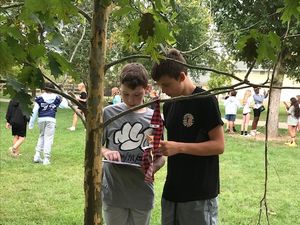
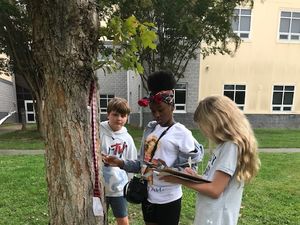




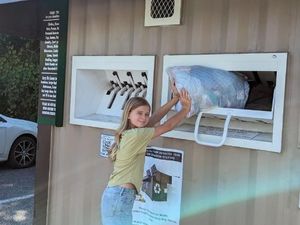
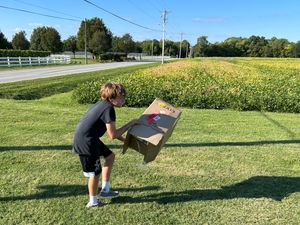

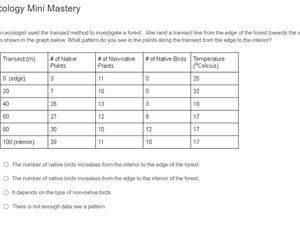
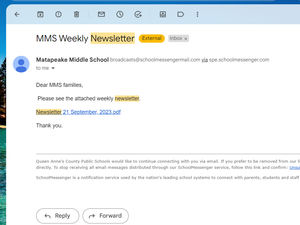
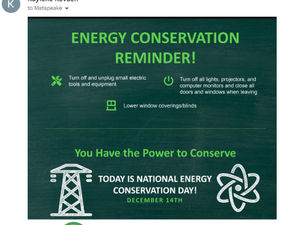
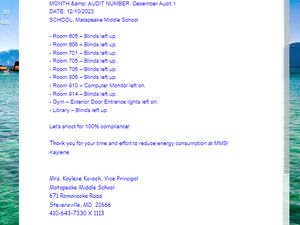




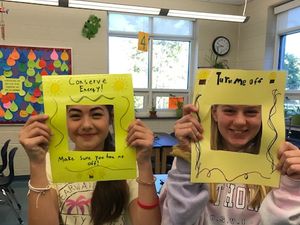






__20231025090000.jpg)
__20231025090000.jpg)

